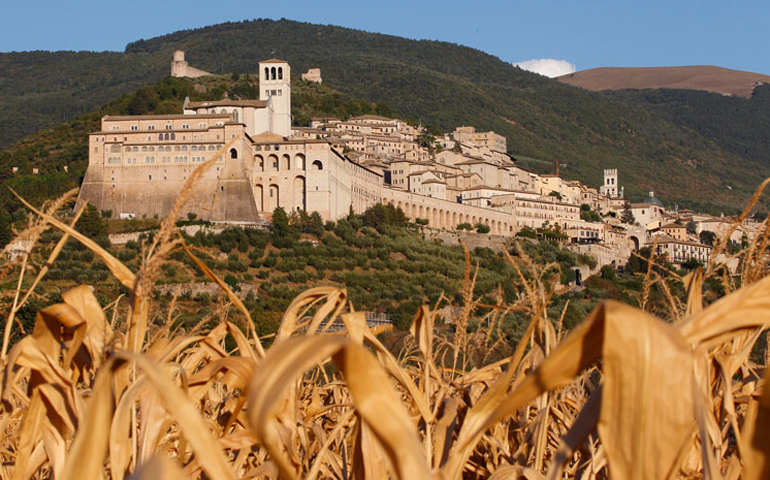
Assisi, Italy, where St. Francis is buried in the basilica built by his friend Elias (CNS/Paul Haring)
 THE ENTHUSIAST: HOW THE BEST FRIEND OF FRANCIS OF ASSISI ALMOST DESTROYED WHAT HE STARTED
THE ENTHUSIAST: HOW THE BEST FRIEND OF FRANCIS OF ASSISI ALMOST DESTROYED WHAT HE STARTED
By Jon M. Sweeney
Published by Ave Maria Press, 291 pages, $18.95
Most people know the life story of Francis of Assisi (1181-1226), mystic, miracle worker, founder of the Franciscan Order, and Roman Catholic saint. At least, they think they know his story.
But according to scholars, many of the stories that people think they know about Francis are fictitious. Since Francis lived nearly 1,000 years ago, many records of his life and work have been lost. In addition, devout followers of the saint often embellished details of his life.
Some followers, like his friend Elias, disagreed with the strictness of Francis' rules regarding material possessions. Others thought Francis had it right when he avowed the importance of poverty. Each group tried to adjust the facts of Francis' life and teachings to agree with their own views. Still other followers tried to make Francis' life conform to the life of John the Baptist: hence the disagreement over Francis' baptismal name, with some saying that it was actually Giovanni (or John) until his father, an upper-middle-class merchant, returned home from a business trip to France and decided to change his son's name to Francesco.
Jon M. Sweeney's latest book, The Enthusiast: How the Best Friend of Francis of Assisi Almost Destroyed What He Started, asserts that Francis was baptized Giovanni, although this differs from the view of the highly respected historian, Dominican Fr. Augustine Thompson. (See my review of Thompson's Francis of Assisi: The Life, NCR, Feb. 28-March 13, 2014.) Sweeney believes that Francis was a complex, multifaceted individual and certainly not the over-the-top hippie poet portrayed in the popular 1972 film, "Brother Sun, Sister Moon," by Franco Zeffirelli. While that portrayal of Francis may have worked for those growing up in the '70s and '80s, Sweeney says it won't work today.
Sweeney, who received a 2015 award for excellence from the Catholic Press Association for his 2014 book, When Saint Francis Saved the Church, believes that today's readers are interested in Francis' complexity. So, in The Enthusiast, he looks at Francis' struggles primarily as they concern his relationship with the controversial Elias. The problem is that there's little accurate information concerning Francis according to scholars. And there's even less concerning Elias of Cortona. (Thompson says he should more accurately be called Elias of Assisi.)
Elias was organized, good with facts and figures and had some university training. Francis founded the Order of Friars Minor in 1208, but seems to have had minimal schooling as well as a tendency to daydream. As Francis' friend and fellow friar, Elias was entrusted with the day-to-day running of the order in about 1221. After Francis' death (1226), Elias was elected leader of the friars.
Elias is the enthusiast of Sweeney's biography, not Francis. But the subtitle is somewhat misleading since Sweeney provides little evidence that Elias ever seriously damaged the Franciscan Order. In addition, both the saint and his companion could be called enthusiastic.
On one side, there is Francis, who is so enthusiastically in love with God and creation that he wrote poems and songs in praise of both. Taken up by his love for Christ, the Eucharist, and the Mass, Francis would allow nothing to hinder his connection to them -- certainly not material objects.
On the other side, there is Elias, who enthused over order and organization. Elias realized that not everyone could go hungry or live without shelter, and his point seems obvious. Yet he became so caught up in it that he lost sight of his purpose, which should have matched Francis' own: to follow in the footsteps of Jesus Christ.
Elias was approximately the same age as Francis. He may have come from the same town. Like Francis, he was also a lay brother who did not become a priest. Sweeney speculates that Elias and Francis were boyhood friends (despite the lack of historical evidence) because the childhood connection would explain the longevity of their friendship. It would also explain the depth of the relationship, since Elias was one of the very few who knew about Francis' stigmata. In his History of the Franciscan Order, scholar John Moorman suggested that there was evidence of a romantic relationship between the two, but Sweeney does not address that subject. He focuses on Elias, who helped Francis draft versions of the Franciscan Rule as well as keep the friars organized. Trusting in Elias' judgment, Francis named Elias as minister general of the order.
When Francis died, Elias protected Francis' corpse and later, out of devotion to the saint, built the basilica that houses his remains, which were so carefully buried that their exact resting place was not found for 600 years. Elias wanted to showcase Francis' holiness even if Francis (who had asked to be buried naked in the ground) would not have approved of such a display.
Elias' views caused dissension in the earliest community because he viewed the Franciscans as a conventional order (one living in monasteries with a modicum of comfort) as opposed to a spiritual one (those relying on others for basic sustenance). Many Franciscans, who strictly followed Francis' example, disagreed. After Francis' death, Elias was thwarted as he several times tried to take control of the order. Later Elias sided with the Emperor Frederick II, against Pope Gregory IX, and was excommunicated. It didn't help his case that he was reported for cruelty, drunkenness, gluttony and hypocrisy.
But is all this true? As Sweeney admits in an afterword, no one is actually sure about much of the information concerning Francis and Elias -- from the nature of their friendship to what exactly Elias did for Francis -- if anything. So Sweeney's book is in some ways more a work of fiction than a work of history.
[Diane Scharper, a frequent contributor to NCR, is the author of Radiant, Prayer Poems. All NCR book reviews can be found at NCRonline.org/books.]


